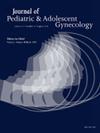Contraceptive Choice and Sexual Behaviors in Both-Sex Attracted Adolescents: A Retrospective Cohort Study
IF 1.7
4区 医学
Q3 OBSTETRICS & GYNECOLOGY
引用次数: 0
Abstract
Study Objective
Bisexual adolescents have higher rates of unintended pregnancy than their heterosexual peers and increased rates of high-risk sexual behaviors. They may be less likely to use effective contraception, though limited data is available. This study sought to compare contraceptive choice and sexual risk behaviors of both-sex attracted and opposite-sex attracted adolescents and young adults (AYA) presenting to a contraception clinic.
Methods
A retrospective chart review of AYA aged 14-24 years who presented for an initial visit to a contraception clinic from 2014 to 2020. The primary outcome was contraceptive choice (long-acting reversible contraception (LARC), non-LARC, or nothing). Secondary outcomes included sexual behaviors. Results were analyzed using Pearson's chi-square and Wilcoxon tests.
Results
A total of 2369 AYA were included in this study. Both-sex attracted and opposite-sex attracted patients were similar in age, race, and ethnicity. There was no difference between groups in percentage selecting LARC (71% vs 66.1%, P = .11). Both-sex attracted patients reported a younger age at first sex (14.6 years vs 15.5 years, P < .001), more lifetime sexual partners (4.1 vs 2.8, P < .001), and a higher prevalence of forced intercourse (21.9% vs 8.8%, P < .001).
Conclusions
Both-sex attracted and opposite-sex attracted AYA patients chose LARCs at similar rates in a setting with standardized contraceptive counseling. Both-sex attracted patients had more sexual risk behaviors. Healthcare providers should be inclusive in their approach to obtaining sexual health histories and providing contraceptive counseling and be cognizant that adolescents with both-sex attraction may be at higher risk of forced intercourse.
男女青少年的避孕选择和性行为:一项回顾性队列研究。
研究目的与异性恋青少年相比,双性恋青少年的意外怀孕率更高,高危性行为的发生率也更高。虽然数据有限,但他们使用有效避孕措施的可能性可能较低。本研究旨在比较在避孕诊所就诊的双性吸引和异性吸引青少年和年轻人(AYA)的避孕选择和性风险行为:对 2014 年至 2020 年期间初次到避孕诊所就诊的 14-24 岁青少年进行回顾性病历审查。主要结果是避孕选择(长效可逆避孕药具 (LARC)、非长效可逆避孕药具或不避孕)。次要结果包括性行为。研究结果采用皮尔逊卡方检验(Pearson's chi-square)和威尔科克森检验(Wilcoxon tests)进行分析。在年龄、种族和民族方面,双性吸引患者和异性吸引患者相似。两组患者选择 LARC 的比例没有差异(71% vs 66.1%,P=0.11)。双性吸引患者的初次性行为年龄较小(14.6 岁 vs 15.5 岁,p < .001),终生性伴侣较多(4.1 vs 2.8,p < .001),强迫性交的发生率较高(21.9% vs 8.8%,p < .001):结论:在接受标准化避孕咨询的情况下,被异性吸引和被异性吸引的青壮年患者选择 LARC 的比例相似。被异性吸引的患者有更多的性风险行为。医疗服务提供者在获取性健康史和提供避孕咨询时应具有包容性,并认识到具有双性吸引力的青少年可能会面临更高的被迫性交风险。
本文章由计算机程序翻译,如有差异,请以英文原文为准。
求助全文
约1分钟内获得全文
求助全文
来源期刊
CiteScore
3.90
自引率
11.10%
发文量
251
审稿时长
57 days
期刊介绍:
Journal of Pediatric and Adolescent Gynecology includes all aspects of clinical and basic science research in pediatric and adolescent gynecology. The Journal draws on expertise from a variety of disciplines including pediatrics, obstetrics and gynecology, reproduction and gynecology, reproductive and pediatric endocrinology, genetics, and molecular biology.
The Journal of Pediatric and Adolescent Gynecology features original studies, review articles, book and literature reviews, letters to the editor, and communications in brief. It is an essential resource for the libraries of OB/GYN specialists, as well as pediatricians and primary care physicians.

 求助内容:
求助内容: 应助结果提醒方式:
应助结果提醒方式:


